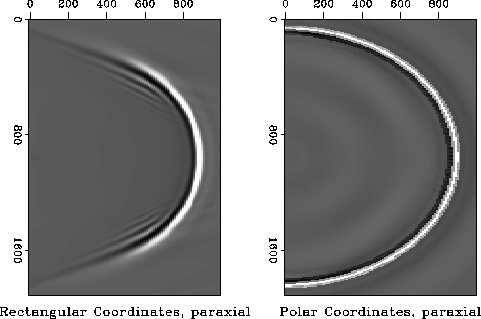The most common way of extrapolating the wavefield in a variable
velocity medium is to use a paraxial approximation to the wave
equation.
The well known ![]() paraxial approximation to equation (1) is,
paraxial approximation to equation (1) is,

Using the usual splitting procedure this becomes,
![]()
![]()
The equations in polar coordinates can be similarly transformed, the paraxial approximation is,

![]()
After splitting this becomes,
![]()
![]()
The results of using these two schemes in a constant velocity space are
shown in figure ![[*]](http://sepwww.stanford.edu/latex2html/cross_ref_motif.gif) . The
. The ![]() approximation is clearly
visible in the rectangular coordinate data. Because the wavefront propagates
at zero degrees to the polar coordinate frame, the polar data does not show
any artifacts due to the
approximation is clearly
visible in the rectangular coordinate data. Because the wavefront propagates
at zero degrees to the polar coordinate frame, the polar data does not show
any artifacts due to the ![]() approximation.
approximation.
 |
Paraxial approximations will not accurately model events that propagate at high angles to the coordinate frame of the finite difference mesh. In rectangular coordinates this means that near vertical waves should be propagated using depth extrapolation, and near horizontal waves would be best modeled using x-extrapolation. If the problem to be solved is one of downward continuing surface data that contains events that are mostly near vertical (e.g. zero offset migration), a rectangular coordinate frame and depth extrapolation are appropriate. On the other hand if the problem is one of modeling a near circular outgoing wavefront from a point source, then polar coordinates and outward radial extrapolation are superior.